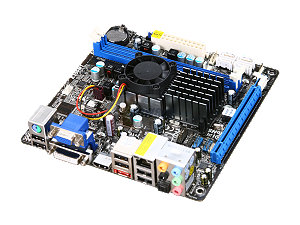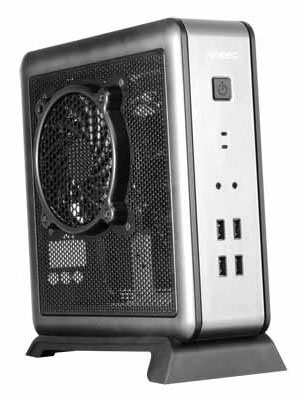Nettop and Mini-ITX Buyer’s Guide
by Zach Throckmorton on April 22, 2011 2:00 PM ESTAMD Zacate Budget Nettop
| AMD Budget Nettop | ||
| Component | Product Name | Price |
| CPU + Mobo | ASRock E350M1 (AMD E-350) | $110 |
| Memory | Patriot 2GB DDR3 1333 PSD32G13332 | $22 |
| Case + PSU | Antec ISK 100 + 90W PSU | $73 |
| Storage | Seagate Momentus 500GB 7200RPM 16MB | $60 |
| Operating System | Windows 7 Home Premium 64-bit | $100 |
| Total Price | $365 | |

Next up is our AMD variant of the budget nettop. We’ll start with the motherboard and CPU (APU) choice, the ASRock E350M1. AMD’s new Fusion APUs (Accelerated Processing Units) combine a dual-core CPU and DX11 graphics onto a single die. AMD refers to this as the E-350 for the dual-core model, and they call the GPU the HD 6310. We’ve already provided ample coverage of AMD’s new platform, and overall Brazos/Zacate is a much more pleasing solution than Intel’s Atom—or even NVIDIA’s ION. Really, there’s not much reason to go with the Intel Atom/ION systems in this guide over this budget AMD nettop unless you can find an Atom board on clearance somewhere. This ASRock board features an eSATA port, as well as VGA, DVI, and HDMI ports. It also uses regular desktop memory so make sure you get the correct type of RAM. We’ve selected a Patriot 2GB DDR3-1333 module, as 2GB is sufficient to run Aero and moderately multitask.

You could easily keep the same case, HDD, and DVDRW as the Intel system, but we’ve mixed things up a bit to provide some other options. This time, we’re going with the Antec ISK 100, which is my favorite mini-ITX enclosure. It includes a silent, high-efficiency 90W external power brick, a quiet but effective 100mm fan, four front USB2 ports, and space for two 2.5” hard drives mounted below the motherboard. Assembly is time-consuming, but the finished product is worth the effort in my opinion. Note that it does not have space for an optical drive, though you can always go the external drive route.
For storage, we’ve selected a Seagate Momentus 500GB 7200RPM drive. This is a drive that we’ve seen in dozens of laptops over the past year, and while performance is nothing like an SSD it will still get the job done. Unlike 3.5” drives, pricing is quite a bit higher, and the minimum ~$40 drives are usually 160GB 5400RPM models (or $45 for a 250GB drive). The choice of case thus ends up increasing the cost of storage, but we’re willing to make the trade in the name of style. You can choose a less expensive drive if you’re looking to cut costs, or perhaps if you want an optimal configuration you could buy a 60GB SSD for the OS and apps and add in a larger 5400RPM drive for mass storage, but that definitely wouldn’t be “budget” by any stretch.
With the selected components, the total system cost comes to $365, so for the added performance and flexibility over the Atom configuration you’re paying $37. If you use the same case and storage options as the Atom setup, the total drops to $355, making the difference just $27. This particular system is also slightly cheaper than the base mobo + CPU we’ll use in the higher-end Intel Atom + ION system, though the other component choices will bump the upgraded system cost up quite a bit. Considering that E-350 is a superior platform overall, the added price relative to stock Atom is worthwhile unless you’re sure you don’t care about Flash video support and other graphically intensive content. We’d prefer to give up hard drive space to afford the extra $27 relative to the base Intel setup, though.










101 Comments
View All Comments
prismatics - Friday, April 22, 2011 - link
That Lian-Li case is $50 more than you have it listed. Is this a mistake or did Newegg change the price since you setup the link?JarredWalton - Friday, April 22, 2011 - link
Sorry, error in the table. I had the wrong labels on the Case + PSU and Storage lines (see first comment), and when I swapped the content around to fix that I missed the pricing information. So the table listed the HDD as $150 and the case as $94 when it was the other way around.obarthel - Friday, April 22, 2011 - link
I enjoyed reading your article, especially since I'll be building a couple or more of those. The article was somewhat informative, but I would have preferred if you'd done a few things differently- review individual components, instead of randomly-matched systems. There's no specific reason to use any one case with any one MB, so why complicate matters ?
- take advantage of that to be more thorough about each component's characteristics. ie, the Antec ISK 100 is **NOT** VESA-mountable, not even with an extra accessory, even though it looks like it could (should ?) be. Also, it's not always clear how big the cases are, whether they have internal vs external PSUs...
- or, if you insist on the "whole system" approach, include a handful of worthy barebones, such as the Asus S1-AT5NM10E, Shuttle XS35/35GT, or the various Zotac models.
In the end, I'd have liked a more conventional "System guide" approach, with maybe 3 use cases:
- HTPC: very quiet, HDMI/DVI, good sound, internal optical drive, IR remote, Linux
- NAS/Torrent server: 3.5" HD (or two), Linux
- Desktop Replacement: VESA-mounted, Bluetooth
- All of the Above.
+ a recommendation for a barebones PC instead of homebrew.
Right now, I'm thinking about an Asus S1-AT5NM10E for my server (Case looks OK, has all the features I need and more, price seems unbeatable), and an Asus E-350 for my Desktop Replacement. Still looking for a VESA-mountable case with no optical disc to go with it.
hnzw rui - Friday, April 22, 2011 - link
>Still looking for a VESA-mountable case with no optical disc to go with it.Have you considered the Mini-Box M350? Caveat, you'd need to buy a PicoPSU but even the lowest model should be more than enough.
obarthel - Friday, April 22, 2011 - link
Thanks, that looks like what I'd want. I'm a bit confused about what I need in terms of PSU and adapter... and bothered by the price ! The case itself is very cheap and looks well designed, though.DanNeely - Friday, April 22, 2011 - link
Most (all?) pico PSU sellers list what each model needs as an AC brick, and sell bricks that work with the picoPSUs they sell. The cheaper models tend to be very picky, while the higher end ones can use almost anything. The difference is between taking 12V in and just making 3.3/5V, and taking 19V (common laptop brick) or car DC (varies significantly) and making all 3 voltages.457R4LDR34DKN07 - Friday, April 22, 2011 - link
This was a decent guide and made me consider building a less power consuming box for my ceton infiniTV4. I could only find 1 case designed for mini itx and a expansion slot the LUXA2 LM100. It might be worth waiting for a i5 2405S.monkeyman1133 - Friday, April 22, 2011 - link
IMO, you should do a more apples-to-apples comparison across the different systems. Just browsing through quickly, my first reaction to the "AMD Upgraded nettop" is $778 for a nettop?? F that. But of course its a very misleading for a number of reasons.First is the unequal software costs included. Are you guys under pressure to include software costs in the price summary? OS cost is once thing, however, I think it makes more sense to exclude it from the "base cost" just like it is in the regular System Builder guides. What is worse and especially confusing, IMO, is when you include the cost for dvd/bluray playback software to only some systems.
Another minor point is that the HDD/storage options and thus cost vary significantly from system to system. Storage options can really be chosen independently of the system, so not keeping this constant across the systems also really skews the comparison.
JarredWalton - Friday, April 22, 2011 - link
We cover this discrepancy in the text on every page. For example, on the ION system: "Using the same case and components, the difference in motherboard choice makes this platform $10 more than the basic AMD E-350 setup, or $37 more than the stock Atom configuration."Really the motherboard/CPU and RAM are the only item that necessarily varies between builds -- well, that and I'd be very hesitant to try a shorter ITX case on the SNB system on the final page without confirming it will fit. We felt it would be more interesting to have multiple case options showing what's out there, discussing storage tradeoffs, etc.
As for the software, there are limitations with most (all?) bundled Blu-ray software packages, and if you want the full HD experience you'd need to purchase additional playback software. We again make this clear in the text.
Will some people just look at the bottom line and then leave? Perhaps, but then they're no longer "readers" of our site, are they? If all someone wants to do is look at a table or a chart and call it good (or bad), we can't really stop that and such a person is ultimately missing out on information that is readily available.
iuqiddis - Friday, April 22, 2011 - link
Another software option would be to get a DVDFab decrypting software for blu-ray playback. I've never come across a disc that it failed to decrypt. It runs as a driver; you can just open the bluray disc with VLC to view them.